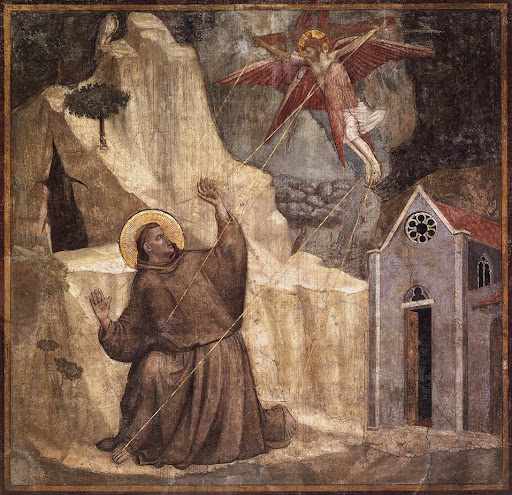I visited the Medieval Wing of the museum. As expected, I was greeted by a large array of church related sculptures, paintings, stained glass, and artifacts--no surprise there. However, I found myself being quite drawn to tapestries. A week later, I still cannot explain why I was so taken; perhaps is was the amount of detail, or the content, the size...who knows? All I know was that I actually found myself marveling at art.
The fist piece that caught my eye was a tapestry of St. Francis receiving stigmata. Stigmata, as most of you probably know, are marks resembling the wounds Christ received while being crucified. They are inflicted supernaturally on faithful servants of the Lord. Unfortunately, I could not find a picture of it online and the one I sneaked on my phone looks like garbage but this picture is somewhat similar and will convey the message of the tapestry I speak of.

 The second piece that caught my eye, honestly at first glance just by its sheer magnitude, was Scenes from The Story of the Trojan War: The Battle with the Sagittary and the Conference at Achilles' Tent. As I stood there and marveled at the detail, a question mark bestowed itself upon my brain. I started to think how peculiar it was to have such a referential piece of art in such a Christian time. This era was all about doing away with the "heathen ways of old." It was puzzling and made me admire the piece even more. As you can see, it is quite intricate. I have posted a brief blurb taken from the Met's website beneath the picture for your learning and reading pleasure.
The second piece that caught my eye, honestly at first glance just by its sheer magnitude, was Scenes from The Story of the Trojan War: The Battle with the Sagittary and the Conference at Achilles' Tent. As I stood there and marveled at the detail, a question mark bestowed itself upon my brain. I started to think how peculiar it was to have such a referential piece of art in such a Christian time. This era was all about doing away with the "heathen ways of old." It was puzzling and made me admire the piece even more. As you can see, it is quite intricate. I have posted a brief blurb taken from the Met's website beneath the picture for your learning and reading pleasure.These pieces are fragments of two or more tapestries that were woven after a cartoon illustrating a composition in the Trojan War series. Among the composition's episodes were the three illustrated here: the fifth battle, in which the centaur, or Sagittary, fought on the side of the Trojans; the conference held in Achilles' tent to arrange single combat between Hector and Menelaus; and Hector arming for war as Andromache and Priam urge him not to go. The legend of the Trojan War had special appeal for the dukes of Burgundy, who claimed Priam, the last king of Troy and the father of Hector and Paris, as an ancestor. In September 1472, Charles the Bold, duke of Burgundy, received as a gift a set of Trojan War tapestries that were produced by Pasquier Grenier of Tournai. The Museum's pieces, while probably not part of the original set made for Charles, were likely woven after the same series of cartoons. They are formidable examples of the types of ambitious tapestries produced for the Burgundian court in the Netherlands.
 Christ and the Virgin are shown pleading with God the Father for mercy on behalf of eight small figures, perhaps members of a prominent Florentine family. In the tradition of hieratic scale, the divine figures are portrayed many times larger than the mortals, who kneel in adoration and prayer. Pointing to the wound in his side, Christ says, "My Father, let those be saved for whom you wished me to suffer the Passion." The Virgin, holding one of her breasts, pleads, "Dearest son, because of the milk that I gave you, have mercy on them." The axis of God the Father, the dove of the Holy Spirit, and the kneeling Christ also represents the Trinity. The drama of the bold devotional image, with a geometric composition typical of Florentine painting of the later fourteenth century, was heightened by its original placement inside the entrance of the cathedral, where it faced the length of the vast
Christ and the Virgin are shown pleading with God the Father for mercy on behalf of eight small figures, perhaps members of a prominent Florentine family. In the tradition of hieratic scale, the divine figures are portrayed many times larger than the mortals, who kneel in adoration and prayer. Pointing to the wound in his side, Christ says, "My Father, let those be saved for whom you wished me to suffer the Passion." The Virgin, holding one of her breasts, pleads, "Dearest son, because of the milk that I gave you, have mercy on them." The axis of God the Father, the dove of the Holy Spirit, and the kneeling Christ also represents the Trinity. The drama of the bold devotional image, with a geometric composition typical of Florentine painting of the later fourteenth century, was heightened by its original placement inside the entrance of the cathedral, where it faced the length of the vast
No comments:
Post a Comment